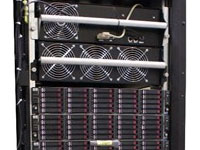Microsoft’s research arm and its Global Foundation Services unit are investigating ways of building the next-generation of energy efficient data centers with fuel cells. But rather than bolt Bloom Energy Servers onto their IT facilities, the company is looking into a more integrated solution.
In a research paper, Microsoft describes how placing compact fuel cells in the midst of rack-mounted IT equipment could lead to major efficiency gains.
As Sean James, Senior Research Program Manager, Microsoft Global Foundation Services, explains in a blog post…
Fuel cells are not limited by the Carnot Cycle Efficiency limit that conventional generators are. Fuel cells are very clean, reliable and perfect for small form factor applications. By integrating fuel cells with IT hardware, we can cut much of the power electronics out of the conventional fuel cell system.
The benefits are many. The group’s research shows that setup like the one they describe would result in higher power availability, lower infrastructure costs, PUE and overall energy efficiency gains and the advent of the first renewables-friendly universal design for data centers enabling the mass production of green computing centers. (You know, for all that cloud goodness.)
Why does it matter? By the time it hits the chip level on a conventional grid system, only “less than .2 watts of the original unit of energy or over 80 percent of the energy is lost from the power plant to the server!”
“With our one watt of energy we are now getting almost .4 watts or double the efficiency of traditional datacenters,” writes James.


Leave a Reply